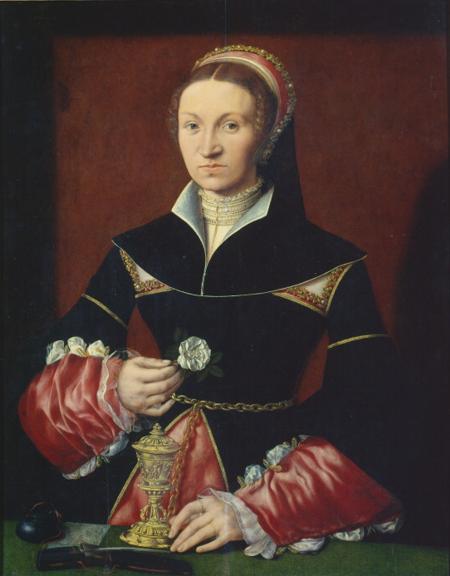

Keeping one’s head in a crisis had a whole different connotation in the 16th century. And the more closely one was related to the King, the more difficult it became.

Believed to be – Ursula Pole, Baroness Stafford
Ursula was born in c1504 the daughter of Sir Richard Pole and Margaret Plantagenet, the daughter of George, Duke of Clarence, brother of two Yorkist Kings Edward IV and Richard III. A close cousin to the Henry VIII (her grandmother Edith St John was half sister to his grandmother, Margaret Beaufort) you could be forgiven for thinking this would have stood the Pole family in good stead.
But despite her impeccable pedigree, Ursula Pole watched as member of her family fell like nine pins.
One of their problems was their continued adherence to the old religion and their allegiance to Catherine of Aragon and her daughter the Princess Mary.
And the other problem was they were just too darn royal. The Pole family were too close to the new Tudor crown for comfort and Henry VIII took every opportunity to weed them out.
As a member of the royal family, Ursula’s marriage was keenly debated. At one point the Duke of Milan was a possible contender but then a match with Henry Stafford, son of the Duke of Buckingham, was suggested by Cardinal Wolsey. The marriage took place on February 16, 1519 when Ursula was about 15 years old and Henry 18.
The couple set up home in her father in law’s household and remained at the centre of court life. Four months pregnant Ursula even joined the royal entourage at Henry’s big show off shindig at the Field of the Cloth of Gold.
But Ursula and Henry had been married barely two years when the first fall of the axe occurred. Henry’s father, Edward 3rd Duke of Buckingham, was charged with treason and executed on Tower Hill on May 17. His crime was his intention to kill the King, however it was more likely his descent from Katherine Woodville, the sister of Elizabeth, Edward IV’s Queen, that sealed his fate. Edward was posthumously attainted by an Act of Parliament and his title and estates, including the Duke’s fabulous castle at Thornbury, were seized by the crown.
Next for the chopping block was Henry Pole, Lord Montagu, Ursula’s eldest brother. On November 4, 1538 Henry, along with his various Neville in laws, was arrested for treason and beheaded on January 9 the following year.
That same year Ursula’s mother Margaret was arrested and charged with colluding with her treacherous sons Henry and Reginald. On May 27, 1541 she was also beheaded. An inexperienced executioner hacked to pieces the head and shoulders of the 68 year old Countess until the job was done.
And when it came to her 9th son Thomas Stafford, poor Ursula must have hung her head. At best a fantasist, Thomas considered himself to be a serious contender for the throne. In league with Wyatt, Thomas rebelled against Queen Mary and the Spanish marriage. Having lived in France for several years, Thomas sailed from Dieppe and on April 18 1557 seized Scarborough Castle, declaring himself Lord Protector. Ten days later he was captured and on May 28 was executed at Tyburn.
Ursula and Henry had 14 children and with the family estates rapidly disappearing they were kept on the move. There is evidence to suggest they lived in a property in Sussex and spent four years in an identified abbey property. They may even have lived in the castle at Stafford granted to them in 1531.
Henry continued to support Queen Mary and was later to reconvert to Catholicism, although whether Ursula followed him remains unknown.
Henry died on April 30, 1563 at Caus Castle, Shropshire and was buried at Worthen Church. Ursula died on August 12, 1570 – further research is required to establish where she was buried.
An enigmatic woman, it can be safely said that Ursula kept her head when all about her others were losing theirs.